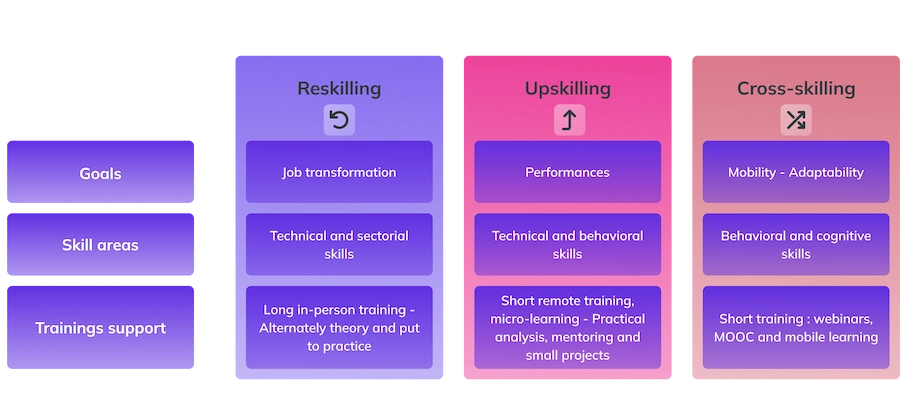The speed at which businesses are changing is causing employees to become very aware of this. In fact, 67% of them consider that this evolution is too fast. Employees are therefore aiming to maintain their employability on the one hand, and to broaden the scope of their skills to other areas on the other. For the company, too, this adaptation is critical to its sustainability. Yet the mismatch of skills persists, as evidenced by the 373,100 positions still vacant at the beginning of 2023. How can we adapt the development of skills to the needs of the company?
The challenges of developing skills
The implementation of a policy for the valorisation of skills is one of the challenges of the Strategic Workforce Planning. The establishment of a system encouraging the development of skills presents human, organizational and economic challenges. What are the stakes?
- Detecting changes in professions and emerging skills
- Adapt to changes in the environment and maintain the company’s performance over the long term.
- Find the right balance between imposing the acquisition of skills and empowering employees
- Measure the progress of the level of skills in a reliable way.
In terms of resources, this approach makes it possible to retain key talent and facilitate internal mobility. It is also an opportunity to maintain the adaptability of individuals to potential economic hazards, as we observed during the Covid-19 job changes, when nearly 20% of employees had to change their role.
Here’s an additional source of information for detecting skills to develop:“How to detect skills needs?”
Anchor the development of skills in the Jobs & Skills Management
The planning of jobs and skills in a medium-term horizon is ensured by the Jobs & Skills Management. This mechanism has replaced the Strategic Workforce Planning since 2017. It is a tool, one of the modalities of which is the investment in the employability of employees so that they can meet the company's strategic objectives.
The Jobs & Skills Management also aims to identify career bridges and profiles that are close to the requirements of a position during an internal HR reorganization.
We explain the differences between Strategic Workforce Planning and Jobs & Skills Management in our page“the Jobs & Skills Management replaces the Strategic Workforce Planning“.
Identify the categories of skills to be developed
In management, the term ” skill ” is a rather broad notion. Before approaching the development of skills, it is therefore necessary to distinguish between individual and collective skills and also to differentiate between technical, behavioral, cognitive or sectoral skills . Thus, depending on the objective, you, as a manager, can facilitate the support of your employees according to the type of skills to be developed.
A majority of the activities are carried out in teams, so the versatility of skills is a criterion for allocating employees to these projects. The operational aspect is nowadays favored by the talents in their own development: the kinesthetic dimension is the most widespread learning lever in parallel with the auditory and visual ones. We therefore recommend increasing the level of skills when they participate in the missions they carry out as a team.
We detail this approach in the article“Categories of skills and HR development“.
Rely on a mapping of skills
The definition of training budgets combines several dimensions:
- The skills priorities to be integrated into the organization
- The impact of legal changes in each profession
- Gaps between required and achieved levels
- Individual wishes
The mapping of skills is the best way to optimize the budget thanks to a visualization of the existing and the rationalization of the investments.
Here is the Guide to Mapping skills for free download.
What methods to develop skills ?
New development supports have appeared such as gamification, micro-learning, metavers, social learning. The methods must combine two dimensions to be effective:
- Adapt to the learning channels preferred by the individual.
- Multiplying the points of contact to really get into the habits.
Additional resources:








